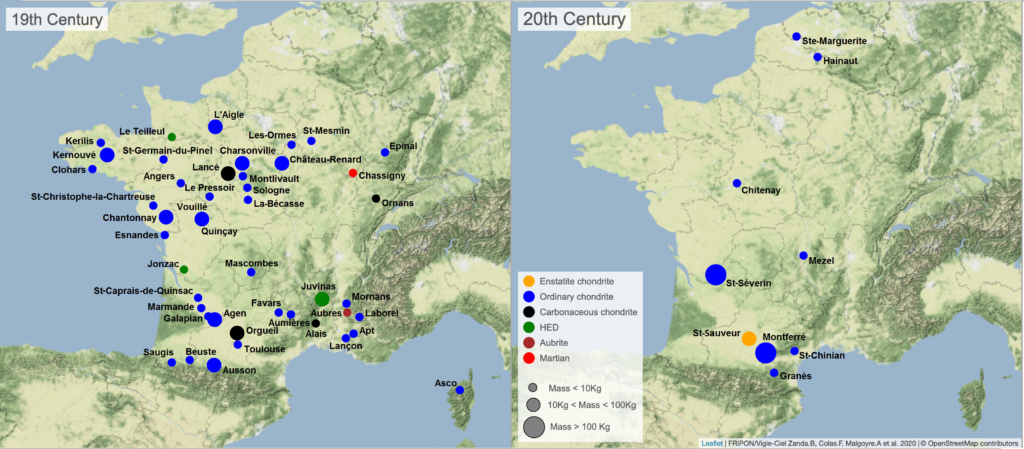In a nutshell:
The FRIPON Science Project (Fireball Recovery and Inter-Planetary Observation Network) was designed to study interplanetary matter by detecting and characterizing fireballs (orbit, trajectory, size, ….) and to recover fresh fallen meteorites to be analyzed in our laboratories.
The core program comprises five main scientific sub-projects:
- Detection of fireballs and computation of their trajectories and orbits;
- Detection of meteorite fall event: computation of meteorite strewn fields, organization of meteorite search;
- Statistical determination of the origins and possibly of the parent bodies of the detected fireballs;
- Statistical estimate of the interplanetary particle impact flux;
- In-depth analysis of the recovered samples.
The FRIPON scientific project is operated by an international team of scientists, which combines the national teams of the countries involved. The team develops and maintains an observational network of Internet connected cameras and radio receivers as well as the tools to retrieve and store the data in a database from which it can be accessed following the policy described hereafter. All the programs developed and used in the FRIPON network are open source, and the scientific methods are shared and optimized to achieve the best use of data. Scientific coordination and animation of the network insures the efficiency of the collaborative work.
More detailed context:
The study of the physical and dynamical properties of interplanetary matter, such as interplanetary dust particles (IDPs), meteoroids, asteroids, comets, is crucial to our understanding of the formation and evolution of the solar system. This matter exists in many sizes, from micron-sized dust grains to several hundred kilometer-sized bodies. Whereas the largest bodies are routinely studied via Earth-based telescopic observations as well as less frequent interplanetary missions, the smallest bodies (diameter ≤10 m) are for the most part only observed and characterized when they enter the Earth’s atmosphere as their entry generates enough light to be recorded by even the simplest types of cameras; the smaller particles are called meteors and the larger bodies are fireballs.
We know that ~100 tons of extraterrestrial material collide with the Earth daily, mostly as small particles less than 0.2 mm in size. At present, these small particles, called IDPs, are actively being collected in the stratosphere, from polar ices, and within impact features on spacecraft. For such particles, the stratospheric collections provide the least contaminated and heated samples. At the other end of the size distribution of extraterrestrial material colliding with the Earth, meteorites are fragments that have survived the passage through the atmosphere without internal chemical alteration, which have been recovered at the surface of the Earth. To date, all known meteorites are pieces of either asteroids, the Moon, or Mars, with asteroidal fragments dominating the flux of material, whereas IDPs originate mostly from comets and possibly from asteroids. The most detailed information on the processes, conditions, timescales, and chronology of the early history of the solar system, including the nature and evolution of the particles in the pre-planetary solar nebula, has so far come from the study of all these extraterrestrial materials. Recovering intact samples of such materials is therefore a critical goal of planetary studies.
However, we are not very efficient at recovering the meteorites that hit the Earth. Estimates based on previous surveys and on collected falls indicate that, for meteorites with masses greater than 100 g, probably less than 1 in 500 that fall on Earth are currently recovered. In addition, taking France as an example, recovery rates were significantly higher in the nineteenth century than they are now: 45 meteorites were observed to fall and found on the ground in the nineteenth century, whereas they were 5 times fewer in the twentieth century (Fig. 1), showing that there is at present a large potential for improvement. Hot and cold deserts are privileged dense collection areas, but most meteorites are found hundreds and up to millions of years after their fall. They have thus been exposed to terrestrial alteration, which has partly obliterated the scientific information they contain. Also, the critical information regarding their pre-atmospheric orbit is no longer available.
The most efficient approach for recovering freshly fallen meteorites is to witness their bright atmospheric entry via dense (60-120 km spacing) camera and radio networks. These networks make it possible to accurately calculate their trajectory from which both their pre-atmospheric orbit and their fall location (with an accuracy on the order of a few hundred meters) can be constrained. The Fireball Recovery and InterPlanetary Observation Network (FRIPON) scientific project was designed in this respect.

